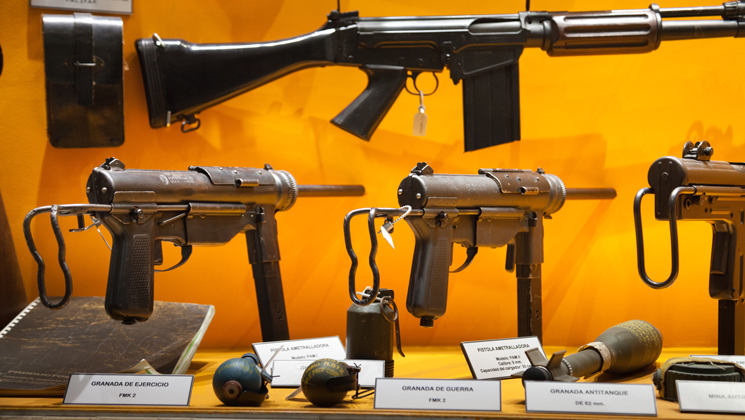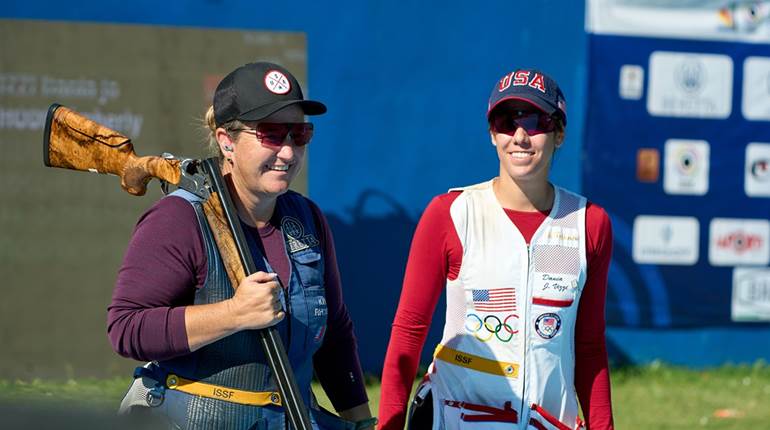
When Argentina began adopting metallic cartridge firearms for its military, it turned to some of the world’s leading gunmaking countries. Germany supplied the Mauser, Italy the BM.59 and Israel the Uzi. Belgium’s Fabrique Nationale sold the South American nation the SAFN-49 rifle, the Fusil Automatique Legere or FAL, the Browning High Power pistol, as well as the MAG-58 machine gun. The United States also contributed several of its best designs, starting with the Remington Rolling Block rifle, and eventually including the M1911A1, the AR-15, M1919A4 .30-cal. machine gun and the M2HB .50-cal. machine gun. Although they were never officially adopted, Argentina even duplicated the Model of 1941 Johnson rifle and the legendary M1 Garand—both in 7.65x53 mm. These were not the only American firearms that Argentina copied, though, because there is another, and it is the iconic Grease Gun.
Five years after the end of World War II, the Argentine military was beginning to consider replacing the obsolete bolt-action rifles that had armed its forces since the 1890s. The time had come to supplement the firepower of belt-fed machine guns with shoulder-fired automatic arms, and to that end the country kicked-off a process that would ultimately result in the adoption of the Fabrique Nationale’s Belgian FAL. But there was an interest in standardizing an economically practical and mass-produced “subfusile” (pistol-caliber submachine gun) as well. Furthermore, the Argentine government wanted to reduce its dependence on foreign arms and, therefore, sought to adopt designs that could be manufactured by the Dirección General de Fabricaciones Militares (the General Directorate of Military Manufacturing or “DGFM”) at the state-owned Fábrica Militar de Armas Portátiles (Military Small Arms Factory or “FMAP”) in the city of Rosario.
Named in honor of the notable 19th century Argentine military leader and politician Domingo Matheu, the FMAP “DM” was already experienced at the mass production of firearms thanks to the Model 1909 Mauser Cavalry Carbine and the 11.25 mm Sistema Model 1927 automatic pistol. Keeping the “DM” small arms factory in operation would therefore serve national military and economic interests at the same time, so Buenos Aires chose to adopt automatic arms that could be produced domestically. With that in mind, it secured production rights for the “U.S. Submachine Gun, Caliber .45, M3A1” or “grease gun” in October 1950 after extensive demonstrations of its ruggedness and reliability. By that time, the M3 was a combat proven design that had served effectively during World War II. Although its M3A1 variant did not fight during that conflict, it nevertheless provided an obvious product improvement that the FMAP was about to put into production under the designation Pistola Ametralladora 1, or PAM-1.
Like the U.S. M3A1, the PAM-1 uses welded sheet metal receiver halves and a steel bolt with fixed firing pin that reciprocates on two spring guides. In addition to that, it features a multi-purpose wire buttstock that also provides a barrel bushing wrench, a magazine loader and a cleaning rod. There is an oiler that threads into the gun’s pistol grip just like on the U.S. M3A1, and a steel flange attached to the ejection port cover provides the gun’s only safety, also just like on the M3A1. Retracting the PAM-1’s bolt is identical to the M3A1 in so far as it is done using the right index finger.
These similarities notwithstanding, the PAM-1 differs from the M3A1 in three critical areas. First of all, it uses a flip-type rear sight with settings for 50 and 100 meters instead of the fixed aperture featured on the U.S. model. Secondly, the PAM-1 chambers the 9 mm Luger cartridge instead of .45 ACP, although it feeds from a similar detachable double-row/double-feed box magazine. Thirdly, the PAM-1 is lighter at 7.27 lbs. compared to the M3A1’s weight of just under 8 lbs.
The national crest and maker roll marks of a PAM-1 in the collection of The Museo de Armas de la Nación in Buenos Aires.
The Domingo Matheu factory began making the PAM-1 in 1954 and, because the design was ideally suited for mass-production, the factory began turning out over 400 units per month from the start. Production continued until 1961 at which time it was interrupted when the factory tooled-up to begin licensed production of the FN FAL. By then, just over 34,000 PAM-1 submachine guns had been made, most of which served the various branches of the Argentine military. National and provincial police forces also used the PAM-1 during the latter years of the 1950s providing a significant body of experience that emphasized just how dependable the Grease Gun design could be. But those years of service experience also revealed a safety hazard that the U.S. military was already well aware of: with a loaded magazine in the magazine well, with the ejection port cover open, and the bolt forward, the PAM-1 could be made to inertia fire if dropped from a sufficient height. In U.S. military service, the fact that the Grease Gun was not drop safe led to negligent discharges and even fatalities. By 1961, the Argentinians were dealing with the same problem, and they decided to do something about it during the production pause. Engineers at the FMAP tackled the issue by introducing a simple grip safety bar directly behind the magazine well that, when depressed, allows the bolt to move forward when the trigger is pulled. If the grip safety bar is not depressed by the shooter’s support hand, the bolt will not travel forward with the pull of the trigger. It was a simple, homegrown engineering solution that introduced an additional layer of safety to the system, and it could even be installed on all of the existing PAM-1s.
One of the PAM-2s in the collection of The Museo de Armas de la Nación in Buenos Aires is shown here fieldstripped to its basic components.
In 1963, the FMAP began producing the revised gun with the grip safety under the designation PAM-2, and it also began modifying guns made prior to the 1961 production pause. But at that point in the factory’s history, there was more going on than a decade earlier when nearly 400 PAM-1s were coming off the assembly line each month. As PAM-2 production began, the factory was still making the Sistema Model 1927 automatic pistol, and licensed production of the FAL was also taking up a significant block of the factory floor. In addition to that, the heyday of the “subfusile” was waning and the era of the modern battle rifle was waxing. These changing circumstances meant that production of the PAM-2 remained at lower levels than the earlier PAM-1. Between 1963 and the end of production in 1972, only 1,100 PAM-2s were built from the ground up, but 16,500 PAM-1s were upgraded by addition of the grip safety mechanism during the same time period.
Two Argentine soldiers pose for a photograph during the occupation of the Falkland Islands in April 1982. The soldier at left is armed with a PAM-2 submachine gun.
This group of well-armed Argentine soldiers poses for a photograph during the occupation of the Falkland Islands in April 1982. The weapons seen here are: the FM FAL (Fusil Automatico Liviano or Light Automatic Rifle), the FM FAP (Fusil Automatico Pesado or Heavy Automatic Rifle), the FM 9 mm “High Power” pistol, the U.S. 90 mm M67 recoilless rifle and the FM PAM-2 submachine gun.
An Argentine soldier armed with a PAM-2 submachine gun stands by a group of tents during the occupation of the Falkland Islands in April 1982.
Although the FMAP began making the 9 mm Luger FMK-3 submachine gun in 1974, the old Rosario Grease Guns remained in service into the 1980s. In fact, examples armed Argentine troops during the 1982 war with the United Kingdom over sovereignty of a series of islands in the South Atlantic. Several photographs taken during the occupation of the Falkland Islands show that the PAM-2 was definitely there, but that conflict really marked the end of its official service.
This exhibit case in the Museo de Armas de la Nación in Buenos Aires features arms manufactured by the Dirección General de Fabricaciones Militares (the General Directorate of Military Manufacturing or “DGFM”) and displays examples of both the PAM-1 and the PAM-2 submachine guns.
Today, semi-automatic only conversions and deactivations are available on the commercial market in Argentina, but unaltered full-automatics are now only found in museums. The Museo de Armas de la Nación on Plaza San Martin in the Retiro district of Buenos Aires displays examples of both the PAM-1 and the PAM-2 in a case featuring weapons manufactured by the DGFM. Just around the corner in the museum’s “Paseo de la Libertad” gallery, an exceptional PAM-1 is exhibited with a custom-made wooden carrying case. It is serial number CA 00011 and it is a special piece that was given a blued finish and presented to a high-ranking government official. Across town, PAM-2 serial number 31003 is part of the collection of the Museo Policia Federal in the district of San Nicolás. It might be unexceptional, but it is nevertheless a perfect type sample of the 1,100 PAM-2s built between 1963 and the end of production in 1972.
PAM-1 serial number CA00011 is a special example that was presented to a high-ranking Argentine government official. It is displayed in the “Paseo de la Libertad” gallery of the Museo de Armas de la Nación in Buenos Aires.
PAM-1 serial number CA00011 is displayed with a custom-made wooden carrying case that holds the gun, two 30-round magazines, an oiler made from a chromed .50-cal. casing marked Lubricante and a similar container of anti-rust solvent marked Antioxido.
This close-up of PAM-1 serial number CA00011 shows the flip adjustable rear sight assembly and the handsome national crest and maker roll marks.
Although they are now largely consigned to museum displays and footnotes, the PAM-1 and PAM-2 submachine guns that once armed Argentine military and police forces are part of the extended family of the legendary General Motors Grease Gun—a firearm that was born of the mass production exigencies of World War II that lived on to fight during the struggle for the Falklands in 1982.
PAM-2 serial number 31003 is one of the examples belonging to the collection of the Museo Policia Federal in Buenos Aires.
The ejection port cover of PAM-2 serial number 31003 is shown here in the open position revealing the design’s strong similarities to the U.S. M3A1 submachine gun.


These photographs of the left side of PAM-2 serial number 31003 provides a great view of the gun’s grip safety lever and shielded magazine release.

This photograph of the right side of PAM-2 serial number 31003 shows its rather modest receiver roll markings.
Additional Reading:
When Argentina Had To Choose a New Service Rifle






































